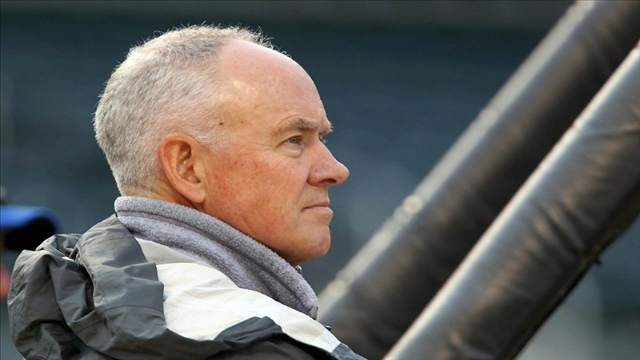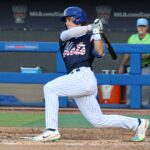You’ve heard me refer to Sandy Alderson as a dinosaur before or repeatedly saying that he seems out of his element. His moves thus far, few as they may be, have done nothing to change my perception of him.
When Omar Minaya was fired, it was my hope that he would be replaced with a young and more progressive GM – with my first choice being Rangers GM Jon Daniels. Daniels was interested in the Mets opening and had hoped the team would hold of on making a decision until his team finished the postseason. It never happened and at least for the next four years we’re stuck with Alderson who was the only GM candidate to get a second interview after a one-week search.
You may remember me calling the new collective bargaining agreement a stunning blow for the old way of team building, namely Alderson. The new CBA took Alderson’s legs right out from under him and he was left wobbling. Now it was either sink or swim.
Some of the new changes like removing Type A and B players, abolishing the old compensation rules, not being able to receive comp picks unless a player was on your roster for an entire season, and making your pending free agent player a qualifying offer of at least $12.5 million or risk no compensation, threw Sandy Alderson’s way of doing things into complete and utter chaos. Hoarding draft picks and getting rid of your best players to do it is now a thing of the past. And I say good riddance to it.
That said, even though the new CBA rules were in effect for the 2012 season, Sandy still ran the offseason as if nothing had changed, targeting under-achieving veterans and players coming off injury to fill out his roster. He maintained his same way of doing business almost as if it were an act of defiance.
You’ve all heard of the term Moneyball, but have any of you ever heard of Sandyball? Here’s an excerpt from an article written in 2008, that explains what Sandyball is…
Get extra draft picks: This is done by offering salary arbitration to a free agent who played for your club the previous season. If the player declines and signs with another team, the original club gets one or two high-end picks in the next June amateur draft. Under Alderson, the Padres have obtained 12 extra picks, including seven in 2007 and another three for the upcoming June draft. From 2000-2005, they had two extra picks. “The farm system has improved,” Alderson said. “That’s partly because of more draft picks. But it’s also partly more effective use of draft picks.
Hire veterans on short-term contracts: The club has made a habit of acquiring major leaguers who can be free agents at season’s end, or signing veterans to one-year contracts. More to the point, the Padres fish those waters year-round. Alderson has said such players can be extra motivatated by the prospect of imminent free agency. Further, such a player can strengthen the farm system if his departure nets a draft pick or two.
“People sometimes criticize us for taking on older players who might have an injury history,” Alderson said. “While we do that from time to time, not only do we do it to help us at the major league level, but we hope that in some cases they will, through draft picks, help us for the future.”
Unfortunately for the San Diego Padres, all those extra draft picks did nothing to move the franchise or the farm system forward. The overwhelming majority of them never made it past Double-A. In fact, when the front office shed the team of many top players who were fan favorites (sound familiar?), that well publicized 2007 Draft that netted the Padres seven first round picks, resulted in this:
Nicholas G. Schmidt, LHP
Kellen R. Kulbacki, LF
Andrew L. Cumberland, SS
Mitchell D. Canham, C
Cory R. Luebke, LHP
Daniel A. Payne, CF
Eric S. Sogard, 2B
When Padres owner John Moores signed Alderson to a five-year deal in the Spring of 2005, he said “I think this is our most significant signing in the 11 years I’ve owned the team.”
Alderson inherited a team that was good enough to win two NL West Titles in 2005 and 2006, but after a series of unproductive drafts and the purging of many of the Padres’ top players for draft picks, the team quickly fell on hard times and has never recovered ever since.
Cesar Carrillo and Cesar Ramos were Alderson’s first two picks in 2005. The two first rounders in 2006; Matt Antonelli and Kyler Burke never panned out. I’ve already mentioned the 2007 draft in which Alderson was very complicit, and 2008 saw Allan Dykstra, Jaff Decker and Logan Forsythe get selected in the first round. In 2009 the Padres only had one first rounder and they selected Donavan Tate, and the 2010 Draft saw the Pads draft Karsten Whitson. By my count, the Padres were 0-for16 in first rounders from 2005-2010.
During that same span, the Mets drafted Mike Pelfrey, Ike Davis and Matt Harvey. The Mets were 3-for-7 in first rounders in that same span. That may not sound so good either, but remember these famous words on the subject of drafts:
“The draft has never been anything but a f***ing crapshoot. We take fifty guys and we celebrate if two of them make it. In what other business is two for fifty a success? If you did that in the stock market, you’d go broke.” – Billy Beane
If Beane call’s 2-for-50 a success, what would he say about Minaya’s 3-for-7 in his first rounders? And he did it while earning one division title and four winning seasons in six at the same time.
So we are back to building from within and that’s all fine with me. What worries me is the track record of the one heading the transition team. What worries me is that abortion that took place in the 2012 Draft.
These are the things that concern me – not the rebuilding itself, but those charged with the rebuilding. And so far this is looking much like the same plan that was used and failed before. Don’t take my word for it… Ask any San Diego Padre fan.















